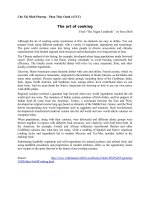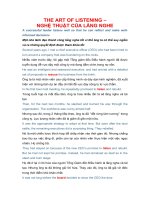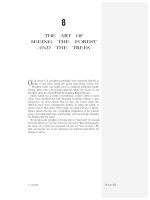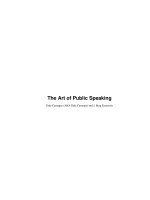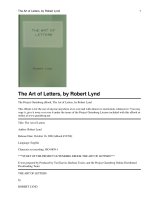95446078 art of programming contest SE for uva pdf
Bạn đang xem bản rút gọn của tài liệu. Xem và tải ngay bản đầy đủ của tài liệu tại đây (255.62 KB, 35 trang )
This course material is now made available for public usage.
Special acknowledgement to School of Computing, National University of Singapore
for allowing Steven to prepare and distribute these teaching materials.
CS3233
Competitive Programming
p
g
g
Dr. Steven Halim
Dr.
Steven Halim
Week 02 – Data Structures & Libraries
Focus on Bit Manipulation & Binary Indexed Tree
CS3233 ‐ Competitive Programming,
Steven Halim, SoC, NUS
Outline
• Mini Contest 1 + Break (discussion of A/B)
/
• Some Admins
• Data Structures With Built‐in Libraries
– Just a quick walkthrough
• Read/experiment with the details on your own
Read/experiment with the details on your own
– Linear Data Structures (CS1010/1st half of CS2020)
nd half of CS2020))
– Non Linear Data Structures (CS2010/2
(
• Focus on the red highlights
• “Top Coder” Coding Style (overview) + Break
• Data Structures With Our‐Own Libraries
– Focus on Binary Indexed (Fenwick) Tree
CS3233 ‐ Competitive Programming,
Steven Halim, SoC, NUS
Basic knowledge that all ICPC/IOI‐ers
Basic knowledge that all ICPC/IOI
ers must have!
must have!
LINEAR DATA STRUCTURES
WITH BUILT‐IN LIBRARIES
CS3233 ‐ Competitive Programming,
Steven Halim, SoC, NUS
I am
I am…
1. A pure C coder
2. A pure C++ coder
A pure C++ coder
3. A mix between
C/C
C/C++ coder
d
4. A pure Java coder
p
5. A multilingual
coder: C/C++/Java
d C/C++/J
0
0 of 120
CS3233 ‐ Competitive Programming,
1
Steven Halim, SoC, NUS
0
0
0
2
3
4
0
5
Linear DS + Built In Libraries (1)
Linear DS + Built‐In Libraries (1)
1. Static Array, built‐in support in C/C++/Java
2. Resize
Resize‐able:
able: C++ STL vector, Java Vector
C++ STL vector, Java Vector
– Both are very useful in ICPCs/IOIs
• There are 2 very common operations on Array:
There are 2 very common operations on Array:
– Sorting
– Searching
S
hi
– Let’s take a look at efficient ways to do them
CS3233 ‐ Competitive Programming,
Steven Halim, SoC, NUS
Two “fundamental”
Two
fundamental CS problems
CS problems
SORTING + SEARCHING
INVOLVING ARRAY
CS3233 ‐ Competitive Programming,
Steven Halim, SoC, NUS
Sorting (1)
Sorting (1)
• Definition:
– Given unsorted stuffs, sort them… *
,
• Popular Sorting Algorithms
– O(n
O( 2) algorithms: Bubble/Selection/Insertion Sort
) l ih
B bbl /S l i /I
i S
– O(n log n) algorithms: Merge/Quick^/Heap Sort
– Special purpose: Counting/Radix/Bucket Sort
• Reference:
– />CS3233 ‐ Competitive Programming,
Steven Halim, SoC, NUS
Sorting (2)
Sorting (2)
• In ICPC, you can “forget” all these…
– In general, if you need to sort something…,
g
, y
g ,
just use the O(n log n) sorting library:
• C
C++ STL algorithm:: sort
STL algorithm:: sort
• Java Collections.sort
• In
In ICPC, sorting is either used as preliminary step
ICPC sorting is either used as preliminary step
for more complex algorithm or to beautify output
– Familiarity with sorting libraries is a must!
Familiarity with sorting libraries is a must!
CS3233 ‐ Competitive Programming,
Steven Halim, SoC, NUS
Sorting (3)
Sorting (3)
• Sorting routines in C++ STL algorithm
– sort – a bug‐free implementation of introsort*
g
p
• Fast, it runs in O(n log n)
• Can sort basic data types (ints, doubles, chars), Abstract
Can sort basic data types (ints, doubles, chars), Abstract
Data Types (C++ class), multi‐field sorting (≥ 2 criteria)
– partial_sort
partial sort – implementation of heapsort
implementation of heapsort
• Can do O(k log n) sorting, if we just need top‐k sorted!
– stable_sort
stable sort
• If you need to have the sorting ‘stable’, keys with same
values appear in the same order as in input
values appear in the same order as in input
CS3233 ‐ Competitive Programming,
Steven Halim, SoC, NUS
Searching in Array
Searching in Array
• Two variants:
– When the array is sorted versus not sorted
y
• Must do O(n) linear scan if not sorted ‐ trivial
• Can use O(log n) binary search when sorted
(
)
– PS: must run an O(n log n) sorting algorithm once
(
g )
g g
• Binary search is ‘tricky’ to code!
– Instead, use C++ STL algorithm::lower_bound
I t d
C STL l ith l
b
d
CS3233 ‐ Competitive Programming,
Steven Halim, SoC, NUS
Linear DS + Built In Libraries (2)
Linear DS + Built‐In Libraries (2)
3. Array of Boolean: C++ STL bitset
– Faster than array of bools
y
or vector<bool>!
– No specific API in Java that is similar to this
4 Bitmask
4.
Bit
k
– a.k.a. lightweight set of Boolean or bit string
– Explanation via:
/>
CS3233 ‐ Competitive Programming,
Steven Halim, SoC, NUS
Linear DS + Built In Libraries (3)
Linear DS + Built‐In Libraries (3)
5. Linked List, C++ STL list, Java LinkedList
– Usually not used in ICPCs/IOIs
y
/
– If you need a resizeable “list”, just use vector!
6 Stack, C++ STL stack, Java Stack
6.
St k C STL t k J
St k
– Used by default in Recursion, Postfix Calculation,
Bracket Matching, etc
7. Queue, C
Queue, C++ STL queue, Java Queue
STL queue, Java Queue
– Used in Breadth First Search, Topological Sort, etc
– PS: Deque, used in ‘Sliding Window’ algorithm
PS D
d i ‘Slidi Wi d ’ l ith
CS3233 ‐ Competitive Programming,
Steven Halim, SoC, NUS
More efficient data structures
More efficient data structures
NON‐LINEAR DATA STRUCTURES
WITH BUILT‐IN LIBRARIES
CS3233 ‐ Competitive Programming,
Steven Halim, SoC, NUS
Binary Search Tree (1)
Binary Search Tree (1)
• ADT Table (key data)
• Binary Search Tree (BST)
Binary Search Tree (BST)
– Advertised O(log n) for insert, search, and delete
– Requirement: the BST must be balanced!
R
i
h BST
b b l
d!
• AVL tree, Red‐Black Tree, etc… *argh*
• Fret not, just use: C++ STL map (Java TreeMap)
– UVa 10226
UVa 10226 (Hardwood Species)
(Hardwood Species)*
CS3233 ‐ Competitive Programming,
Steven Halim, SoC, NUS
Binary Search Tree (2)
Binary Search Tree (2)
• ADT Table (key exists or not)
• Set (Single Set)
Set (Single Set)
– C++ STL set, similar to C++ STL map
• map stores a (key, data)
t
(k d t ) pair
i
• set stores just the key
– In Java: TreeSet
• Example:
p
– UVa 11849 – CD
CS3233 ‐ Competitive Programming,
Steven Halim, SoC, NUS
Heap
• Heap
– C++ STL algorithm
g
has some heap algorithms
p g
• partial_sort uses heapsort
– C++ STL priority_queue
C++ STL priority queue (Java PriorityQueue) is heap
(Java PriorityQueue) is heap
• Prim’s and Dijkstra’s algorithms use priority queue
• But, we rarely see pure heap problems in ICPC
B t
l
h
bl
i ICPC
CS3233 ‐ Competitive Programming,
Steven Halim, SoC, NUS
Hash Table
Hash Table
• Hash Table
– Advertised O(1) for insert, search, and delete, but:
( )
,
,
,
• The hash function must be good!
• There is no Hash Table in C++ STL (
There is no Hash Table in C++ STL ( in Java API)
in Java API)
– Nevertheless, O(log n) using map is usually ok
• Direct Addressing Table (DAT)
Di t Add
i T bl (DAT)
– Rather than hashing, we more frequently use DAT
– UVa 11340 (Newspaper)
CS3233 ‐ Competitive Programming,
Steven Halim, SoC, NUS
Top Coder Coding Style
Top Coder Coding Style
SUPPLEMENTARY
CS3233 ‐ Competitive Programming,
Steven Halim, SoC, NUS
Top Coder Coding Style (1)
Top Coder Coding Style (1)
• You may want to follow this coding style (C++)
1. Include important
Include important headers
headers
–
–
–
–
–
–
–
–
–
–
–
#include <algorithm>
#include <cmath>
#include <cstdio>
cstdio
#include <cstring>
#include <iostream>
#include <map>
#include <queue>
#include <set>
#include <string>
#i l d <
#include
<vector>
t >
using namespace std;
Want More?
Add libraries that you frequently
use into this template, e.g.:
ctype.h
t
h
bitset
etc
CS3233 ‐ Competitive Programming,
Steven Halim, SoC, NUS
Top Coder Coding Style (2)
Top Coder Coding Style (2)
2. Use shortcuts for common data types
–
–
–
–
typedef
typedef
typedef
typedef
long long
vector<int>
pair<int, int>
vector<ii>
ll;
vi;
ii;
vii;
3 Simplify Repetitions/Loops!
3.
Si lif R titi /L
!
–
–
–
–
–
#define REP(i, a, b)
for (int i = int(a); i <= int(b); i++)
#define REPN(i, n)
REP (i, 1, int(n))
#define REPD(i, a, b)
for (int i = int(a); i >= int(b); i--)
#define TRvi(c, it) \
for (vi::iterator it = (c).begin(); it != (c).end(); it++)
#define TRvii(c,
TRvii(c it) \
for (vii::iterator it = (c).begin(); it != (c).end(); it++)
Define your own loops
style and stick with it!
CS3233 ‐ Competitive Programming,
Steven Halim, SoC, NUS
Top Coder Coding Style (3)
Top Coder Coding Style (3)
4. More shortcuts
–
–
–
for (i = ans = 0; i < n; i++)… // do variable assignment in for loop
while (scanf(
(scanf("%d",
%d , n), n) { … // read input + do value test together
while (scanf("%d", n) != EOF) { … // read input and do EOF test
5. STL/Libraries all the way!
/
y
–
–
–
isalpha (ctype.h)
• inline bool isletter(char c) {
return (c>='A'&&c<='Z')||(c>='a'&&c<='z'); }
abs (math.h)
• inline int abs(int a) { return a >= 0 ? a : -a; }
pow (math.h)
a int b) {
• int power(int a,
int res=1; for (; b>=1; b--) res*=a; return res; }
– Use STL data structures: vector, stack, queue, priority_queue, map, set, etc
– Use STL algorithms: sort, lower
g
,
_bound, max, min, max
,
,
,
_element, next
,
_p
permutation, etc
,
CS3233 ‐ Competitive Programming,
Steven Halim, SoC, NUS
Top Coder Coding Style (4)
Top Coder Coding Style (4)
6. Use I/O Redirection
–
–
–
–
int main() {
// freopen(
freopen("input.txt",
input.txt , "r",
r , stdin); // don
don't
t retype test cases!
// freopen("output.txt", "w", stdout);
scanf and printf as per normal; // I prefer scanf/printf than
// cin/cout, C style is much easier
7. Use memset/assign/constructor effectively!
–
–
–
–
–
memset(dist, 127, sizeof(dist));
// useful to initialize shortest path distances, set INF to 127!
memset(dp_memo, -1, sizeof(dp_memo));
// useful to initialize DP memoization table
memset(arr,
(
, 0,
, sizeof(arr));
(
)); // useful to clear array
y of integers
g
vector<int> dist(v, 2000000000);
dist.assign(v, -1);
CS3233 ‐ Competitive Programming,
Steven Halim, SoC, NUS
Top Coder Coding Style (5)
Top Coder Coding Style (5)
8. Declare (large) static DS as global variable
– All input size is known, declare data structure size LARGER than needed to avoid silly bugs
– Avoid dynamic data structures that involve pointers, etc
Avoid dynamic data structures that involve pointers etc
– Use global variable to reduce “stack size” issue
• Now our coding tasks are much simpler
• Typing less code = shorter coding time
Typing less code = shorter coding time
= better rank in programming contests
CS3233 ‐ Competitive Programming,
Steven Halim, SoC, NUS
Quick Check
Quick Check
1. I can cope with this
p
pace…
2. I am lost with so
many new
many new
information in the
past few slides
f
0
0 of 120
CS3233 ‐ Competitive Programming,1
Steven Halim, SoC, NUS
0
2
5 Minutes Break
5 Minutes Break
• One data structures without built‐in libraries
will be discussed in the last part…
p
– Binary Indexed (Fenwick) Tree
– Graph, Union‐Find Disjoint Sets, and Segment Tree
Graph Union Find Disjoint Sets and Segment Tree
are not discussed in this year’s CS3233 Week02
• Graph DS is covered in details in CS2010/CS2020
G h DS i
d i d t il i CS2010/CS2020
• UFDS is covered briefly in CS2010/CS2020
• Please study Segment Tree on your own
Pl
t d S
tT
– We try not set any contest problem involving Segment Tree
CS3233 ‐ Competitive Programming,
Steven Halim, SoC, NUS
Time Check:
8.30pm
